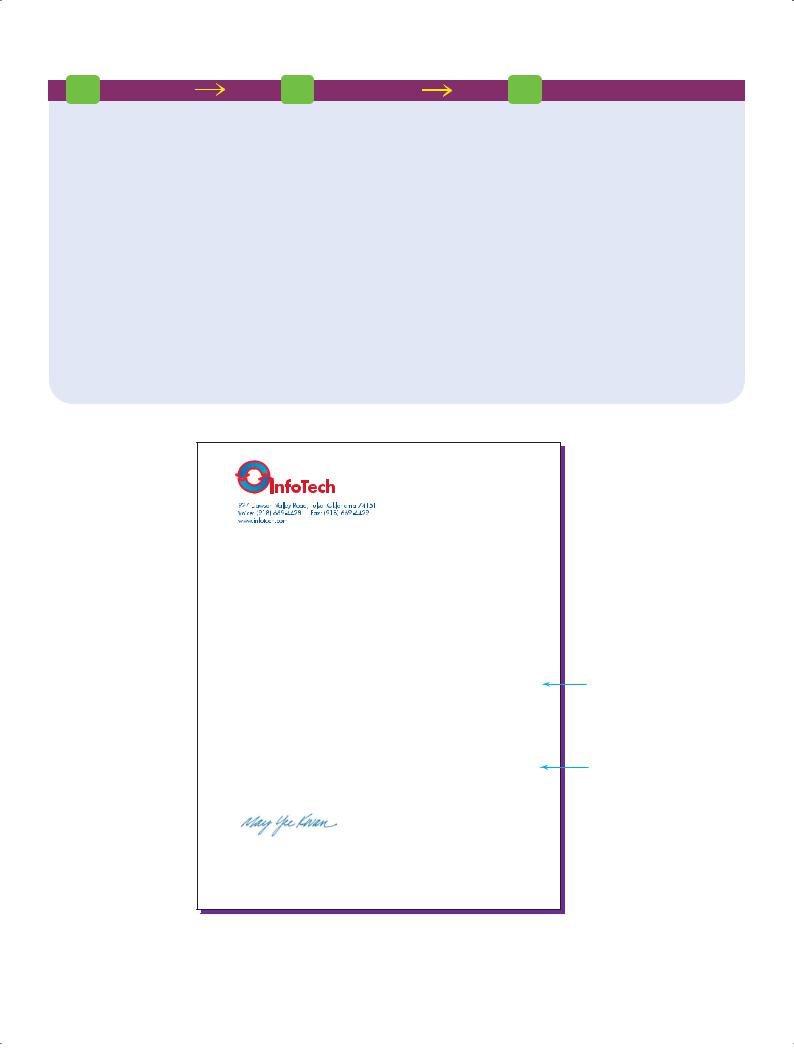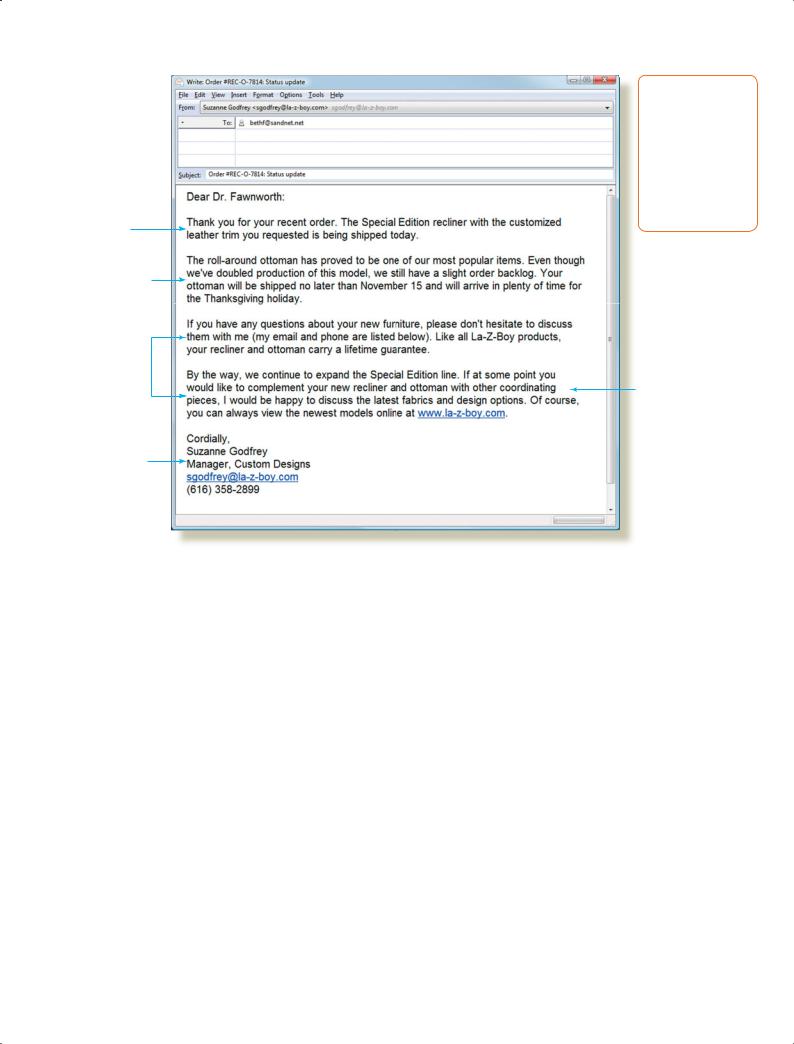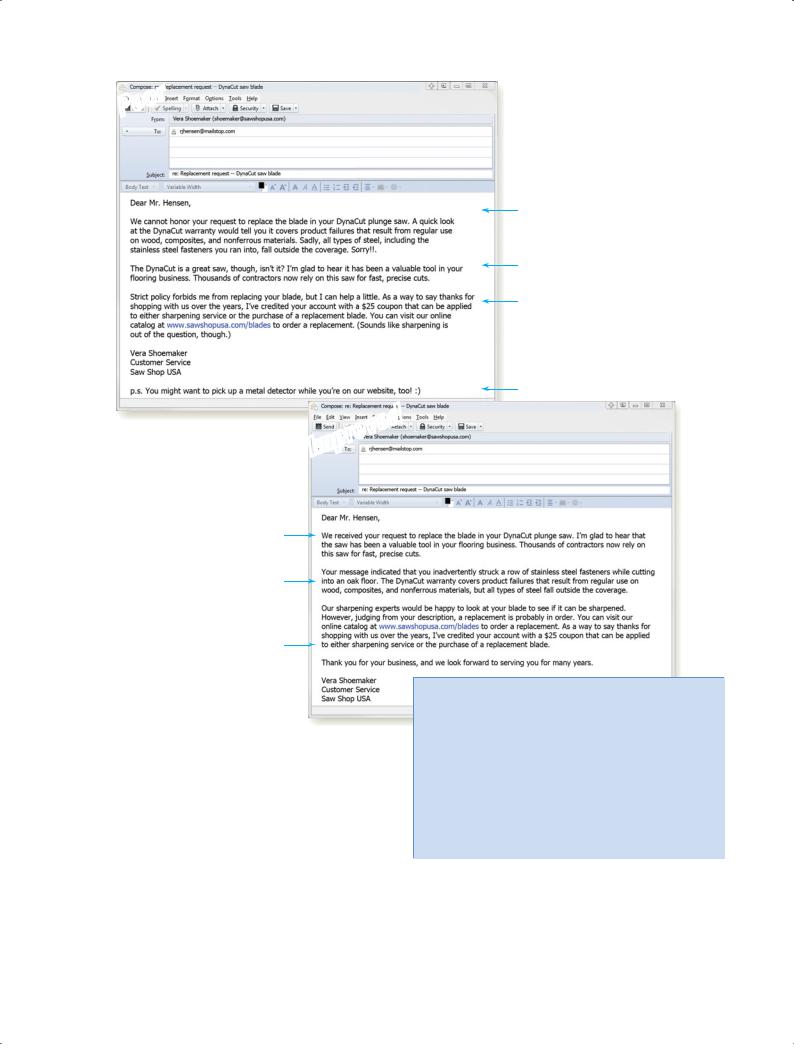
- •Understanding Why Communication Matters
- •Communicating as a Professional
- •Exploring the Communication Process
- •Committing to Ethical Communication
- •Communicating in a World of Diversity
- •Using Technology to Improve Business Communication
- •Chapter Review and Activities
- •Test Your Knowledge
- •Apply Your Knowledge
- •Practice Your Skills
- •Expand Your Skills
- •References
- •Understanding the Three-Step Writing Process
- •Analyzing the Situation
- •Gathering Information
- •Selecting the Right Medium
- •Organizing Your Message
- •Chapter Review and Activities
- •Test Your Knowledge
- •Apply Your Knowledge
- •Practice Your Skills
- •Expand Your Skills
- •References
- •Adapting to Your Audience: Building Strong Relationships
- •Adapting to Your Audience: Controlling Your Style and Tone
- •Composing Your Message: Choosing Powerful Words
- •Composing Your Message: Creating Effective Sentences
- •Composing Your Message: Crafting Coherent Paragraphs
- •Using Technology to Compose and Shape Your Messages
- •Chapter Review and Activities
- •Test Your Knowledge
- •Apply Your Knowledge
- •Practice Your Skills
- •Expand Your Skills
- •References
- •Revising Your Message: Evaluating the First Draft
- •Revising to Improve Readability
- •Editing for Clarity and Conciseness
- •Using Technology to Revise Your Message
- •Producing Your Message
- •Proofreading Your Message
- •Distributing Your Message
- •Chapter Review and Activities
- •Test Your Knowledge
- •Apply Your Knowledge
- •Practice Your Skills
- •Expand Your Skills
- •References
- •Electronic Media for Business Communication
- •Social Networks
- •Information and Media Sharing Sites
- •Instant Messaging and Text Messaging
- •Blogging
- •Podcasting
- •Chapter Review and Activities
- •Test Your Knowledge
- •Apply Your Knowledge
- •Practice Your Skills
- •Expand Your Skills
- •References
- •Strategy for Routine Requests
- •Common Examples of Routine Requests
- •Strategy for Routine Replies and Positive Messages
- •Common Examples of Routine Replies and Positive Messages
- •Chapter Review and Activities
- •Test Your Knowledge
- •Apply Your Knowledge
- •Practice Your Skills
- •Expand Your Skills
- •References
- •Using the Three-Step Writing Process for Negative Messages
- •Using the Direct Approach for Negative Messages
- •Using the Indirect Approach for Negative Messages
- •Sending Negative Messages on Routine Business Matters
- •Sending Negative Employment Messages
- •Sending Negative Organizational News
- •Responding to Negative Information in a Social Media Environment
- •Chapter Review and Activities
- •Test Your Knowledge
- •Apply Your Knowledge
- •Practice Your Skills
- •Expand Your Skills
- •References
- •Using the Three-Step Writing Process for Persuasive Messages
- •Developing Persuasive Business Messages
- •Common Examples of Persuasive Business Messages
- •Developing Marketing and Sales Messages
- •Chapter Review and Activities
- •Test Your Knowledge
- •Apply Your Knowledge
- •Practice Your Skills
- •Expand Your Skills
- •References
- •Applying the Three-Step Writing Process to Reports and Proposals
- •Supporting Your Messages with Reliable Information
- •Conducting Secondary Research
- •Conducting Primary Research
- •Planning Informational Reports
- •Planning Analytical Reports
- •Planning Proposals
- •Chapter Review and Activities
- •Test Your Knowledge
- •Apply Your Knowledge
- •Practice Your Skills
- •Expand Your Skills
- •References
- •Writing Reports and Proposals
- •Writing for Websites and Wikis
- •Illustrating Your Reports with Effective Visuals
- •Completing Reports and Proposals
- •Chapter Review and Activities
- •Test Your Knowledge
- •Apply Your Knowledge
- •Practice Your Skills
- •Expand Your Skills
- •References
- •Finding the Ideal Opportunity in Today’s Job Market
- •Planning Your Résumé
- •Writing Your Résumé
- •Completing Your Résumé
- •Chapter Review and Activities
- •Test Your Knowledge
- •Apply Your Knowledge
- •Practice Your Skills
- •Expand Your Skills
- •References
- •Submitting Your Résumé
- •Understanding the Interviewing Process
- •Preparing for a Job Interview
- •Interviewing for Success
- •Following Up After an Interview
- •Chapter Review and Activities
- •Test Your Knowledge
- •Apply Your Knowledge
- •Practice Your Skills
- •Expand Your Skills
- •References
- •Index

Chapter 8: Writing Negative Messages |
199 |
Third, emphasize what you can do or have done rather than what you cannot do. Also, by implying the bad news, you may not need to actually state it, thereby making the bad news less personal (“Our development budget for next year is fully committed to our existing slate of projects”). However, make sure your audience understands the entire message— including the bad news. If an implied message might lead to uncertainty, state your decision in direct terms. Just be sure to avoid overly blunt statements that are likely to cause pain and anger:
Don’t disguise the bad news when you emphasize the positive.
Instead of This |
Write This |
I must refuse your request. |
I will be out of town on the day you need me. |
|
|
We must deny your application. |
The position has been filled. |
|
|
I am unable to grant your request. |
Contact us again when you have established… |
|
|
We cannot afford to continue the program. |
The program will conclude on May 1. |
|
|
Much as I would like to attend… |
Our budget meeting ends too late for me to |
|
attend. |
|
|
We must turn down your extension request. |
Please send in your payment by June 14. |
|
|
Closing on a Respectful Note
As in the direct approach, the close in the indirect approach offers an opportunity to emphasize your respect for your audience, even though you’ve just delivered unpleasant news. Express best wishes without ending on a falsely upbeat note. If you can find a positive angle that’s meaningful to your audience, by all means consider adding it to your conclusion. However, don’t try to pretend that the negative news didn’t happen or that it won’t affect the reader. Suggest alternative solutions if such information is available and doing so is a good use of your time. If you’ve asked readers to decide between alternatives or to take some action, make sure that they know what to do, when to do it, and how to do it. Whatever type of conclusion you use, follow these guidelines:
■Avoid an uncertain conclusion. If the situation or decision is final, avoid statements such as “I trust our decision is satisfactory,” which imply that the matter is open to discussion or negotiation.
■Manage future correspondence. Encourage additional communication only if you’re willing to discuss your decision further. If you’re not, avoid wording such as “If you have further questions, please write.”
■Express optimism, if appropriate. If the situation might improve in the future, share that with your readers if it’s relevant. However, don’t suggest the possibility of a positive change if you don’t have insight that it might happen.
■Be sincere. Avoid clichés that are insincere in view of the bad news. If you can’t help, don’t say, “If we can be of any help, please contact us.”
Keep in mind that the close can have a lasting impact on your audience. Even though they’re disappointed, leave them with the impression that they were treated with respect.
A respectful close
■Builds goodwill
■Offers a suggestion for action
■Provides a look toward the future
■Is sincere
Sending Negative Messages on Routine Business Matters
Professionals and companies receive a wide variety of requests and cannot respond positively to every single one. In addition, mistakes and unforeseen circumstances can lead to delays and other minor problems that occur in the course of business. Occasionally, companies must send negative messages to suppliers and other parties. Whatever the purpose, crafting routine negative responses and messages quickly and graciously is an important skill for every businessperson.
4 LEARNING OBJECTIVE
Describe successful strategies for sending negative messages on routine business matters.

200 Unit 3: Brief Business Messages
Making Negative Announcements on Routine Business Matters
For unexpected negative messages on routine matters, the indirect approach is usually more appropriate.
Many negative messages are written in response to requests from an internal or external correspondent, but on occasion managers need to make unexpected announcements of a negative nature. For example, a company might decide to consolidate its materials purchasing with fewer suppliers and thereby need to tell several firms it will no longer be buying from them. Internally, management may need to announce the elimination of an employee benefit or other changes that employees will view negatively.
Although such announcements happen in the normal course of business, they are generally unexpected. Accordingly, except in the case of minor changes, the indirect approach is usually the better choice. Follow the steps outlined for indirect messages: open with a buffer that establishes some mutual ground between you and the reader, advance your reasoning, announce the change, and close with as much positive information and sentiment as appropriate under the circumstances.
Rejecting suggestions and proposals, particularly if you asked for input, requires special care and tact because you need to maintain a positive working relationship.
Rejecting Suggestions and Proposals
Managers receive a variety of suggestions and proposals, both solicited and unsolicited, from internal and external sources. For an unsolicited proposal from an external source, you may not even need to respond if you don’t already have a working relationship with the sender. However, if you need to reject a proposal you solicited, you owe the sender an explanation, and because the news will be unexpected, the indirect approach is better. In general, the closer your working relationship, the more thoughtful and complete you need to be in your response. For example, if you are rejecting a proposal from an employee, explain your reasons fully and carefully so that the employee can understand why the proposal was not accepted and so that you don’t damage an important working relationship.
When turning down an invitation or a request for a favor, consider your relationship with the reader.
If you aren’t in a position to offer additional information or assistance, don’t imply that you are.
Some negative messages regarding transactions carry significant business ramifications.
Refusing Routine Requests
When you are unable to meet a routine request, your primary communication challenge is to give a clear negative response without generating negative feelings or damaging either your personal reputation or the company’s. As simple as these messages may appear to be, they can test your skills as a communicator because you often need to deliver negative information while maintaining a positive relationship with the other party.
The direct approach works best for most routine negative responses because it is simpler and more efficient. The indirect approach works best when the stakes are high for you or for the receiver, when you or your company has an established relationship with the person making the request, or when you’re forced to decline a request that you might have accepted in the past (see Figure 8.3).
Consider the following points as you develop routine negative messages:
■Manage your time carefully; focus on the most important relationships and requests.
■If the matter is closed, don’t imply that it’s still open by using phrases such as “Let me think about it and get back to you” as a way to delay saying no.
■Offer alternative ideas if you can, particularly if the relationship is important.
■Don’t imply that other assistance or information might be available if it isn’t.
Handling Bad News About Transactions
Bad news about transactions is always unwelcome and usually unexpected. When you send such messages, you have three goals: (1) modify the customer’s expectations, (2) explain how you plan to resolve the situation, and (3) repair whatever damage might have been done to the business relationship.
The specific content and tone of each message can vary widely, depending on the nature of the transaction and your relationship with the customer. Telling an individual consumer that his new sweater will be arriving a week later than you promised is a much simpler task than telling Toyota that 30,000 transmission parts will be a week late, especially when you know the company will be forced to idle a multimillion-dollar production facility as a result.

Chapter 8: Writing Negative Messages |
201 |
1 Plan |
2 |
Analyze the Situation
Verify that the purpose is to decline a request and offer alternatives; audience is likely to be surprised by the refusal.
Gather Information
Determine audience needs and obtain the necessary information.
Select the Right Medium
For formal messages, printed letters on company letterhead are best.
Organize the Information
The main idea is to refuse the request so limit your scope to that; select the indirect approach based on the audience and the situation.
Write |
3 Complete |
Adapt to Your Audience
Adjust the level of formality based on your degree of familiarity with the audience; maintain a positive relationship by using the “you” attitude, politeness, positive emphasis, and bias-free language.
Compose the Message
Use a conversational but professional style and keep the message brief, clear, and as helpful as possible.
Revise the Message
Evaluate content and review readability to make sure the negative information won’t be misinterpreted; make sure your tone stays positive without being artificial.
Produce the Message
Maintain a clean, professional appearance on company letterhead.
Proofread the Message
Review for errors in layout, spelling, and mechanics.
Distribute the Message
Deliver your message using the chosen medium.
The buffer eases the  recipient into the message
recipient into the message
by demonstrating respect and recapping the request.
Kwan suggests an  alternative, showing
alternative, showing
that she cares about the college and has given the matter some thought.
March 6, 2013
Dr. Sandra Wofford, President
Whittier Community College
333 Whittier Avenue
Tulsa, OK 74150
Dear Dr. Wofford:
Infotech has been happy to support Whittier Community College in many ways over the years, and we appreciate the opportunities you and your organization provide to so many deserving students. Thank you for considering our grounds for your graduation ceremony on June 3.
We would certainly like to accommodate Whittier as we have in years past, but our companywide sales meetings will be held this year during the weeks of May 29 and June 5. With more than 200 sales representatives and their families from around the world joining us, activities will be taking place throughout our facility.
My assistant, Robert Seagers, suggests you contact the Municipal Botanical Gardens as a possible graduation site. He recommends calling Jerry Kane, director of public relations.
We remain firm in our commitment to you, President Wofford, and to the fine students you represent. Through our internship program, academic research grants, and other initiatives, we will continue to be a strong corporate partner to Whittier College and will support your efforts as you move forward.
Sincerely,
May Yee Kwan
Public Relations Director
lc
She provides a meaningful reason for the negative response, without apologizing (because the company is not at fault).
Her close emphasizes the importance of the relationship and the company’s continuing commitment.
Figure 8.3 Effective Letter Declining a Routine Request
In declining a request to use her company’s facilities, May Yee Kwan took note of the fact that her company has a long-standing relationship with the college and wants to maintain that positive relationship. Because the news is unexpected based on past experience, she chose an indirect approach to build up to her announcement.

202 Unit 3: Brief Business Messages
Godfrey uses the buffer to convey the good news.
These two sentences imply the forthcoming bad news by telling the reader what’s being done, not what can’t be done.
The body and close foster a positive ongoing relationship by inviting inquiries and reminding the customer of a key benefit.
She includes helpful contact information.
MyBCommLab
Apply Figure 8.4’s key concepts. Go to mybcommlab.com and follow this path: Course Content Chapter 8
DOCUMENT
MAKEOVERS
She explains the delay and immediately  cushions bad news with a pledge to ship by a definite time.
cushions bad news with a pledge to ship by a definite time.
This resale information encourages future purchasing, but in a way that addresses the customer’s needs, not La-Z-Boy’s.
Figure 8.4 Effective Negative Message Regarding a Transaction
This message, which is a combination of good and bad news, uses the indirect approach—with the good news serving as a buffer for the bad news. In this case, the customer wasn’t promised delivery by a certain date, so the writer simply informs the customer when to expect the rest of the order. The writer also takes steps to repair the relationship and encourage future business with her firm.
Source: Used with permission from Microsoft.
Your approach to bad news about business transactions depends on the customer’s expectations.
If you’ve failed to meet expectations that you set for the customer, an element of apology should be considered.
If you haven’t done anything specific to set the customer’s expectations—such as promising delivery within 24 hours—the message simply needs to inform the customer of the situation, with little or no emphasis on apologies (see Figure 8.4).
If you did set the customer’s expectations and now find that you can’t meet them, your task is more complicated. In addition to resetting those expectations and explaining how you’ll resolve the problem, you may need to include an element of apology. The scope of the apology depends on the magnitude of the mistake. For the customer who ordered the sweater, a simple apology followed by a clear statement of when the sweater will arrive would probably be sufficient. For larger business-to-business transactions, the customer may want an explanation of what went wrong to determine whether you’ll be able to perform as you promise in the future.
To help repair the damage to the relationship and encourage repeat business, many companies offer discounts on future purchases, free merchandise, or other considerations. Even modest efforts can go a long way to rebuilding a customer’s confidence in your company.
Use the indirect approach in most cases of refusing a claim.
Refusing Claims and Requests for Adjustment
Customers who make a claim or request an adjustment tend to be emotionally involved, so the indirect approach is usually the better choice when you are denying such a request. Your delicate task as a writer is to avoid accepting responsibility for the unfortunate situation and yet avoid blaming or accusing the customer. To steer clear of these pitfalls, pay special attention to the tone of your letter. Demonstrate that you understand and have considered the complaint carefully, and then rationally explain why you are refusing the request. Close on a respectful and action-oriented note (see Figure 8.5). And be sure to respond quickly.

Chapter 8: Writing Negative Messages |
203 |
Poor
The direct approach is not the right choice for this message, and the opening is way too blunt, even for the direct approach. The second sentence is somewhat insulting, and “Sadly” and “Sorry!!” sound unprofessional.
This upbeat paragraph, coming immediately after the disappointing and insulting opening, will only annoy the reader.
The information about the $25 coupon is positive and presented well. However, hiding behind “policy” in the first sentence only tells the reader that the company is unwilling to consider each customer’s needs individually.
This misguided attempt at humor is insulting. The reader already knows about the problem; he wants a solution.
The opening confirms the customer’s claim, letting him know his request has been considered. Notice also how the writer confirms the high level of satisfaction with the product in general—signaling that the situation at hand is not a product problem.
The second paragraph offers more confirmation that the reader’s message was heard. The description of the warranty lays out the reasoning for the refusal, which is presented indirectly at the end of the paragraph.
The writer continues with helpful advice and the offer of a $25 discount, and then concludes on a positive, respectful note.
Improved
Pointers for Refusing Claims
ssUse the buffer to indicate that you received and understand the request or complaint
ss In the body, provide an accurate, objective account of the transaction. ss Make the refusal clear without being abrupt, insulting, or accusatory.
ssMaintain an impersonal tone that doesn’t offend the reader.
ssDon’t apologize for refusing, since your company hasn’t done anything wrong.
ssIf appropriate, offer an alternative solution.
ssEmphasize your continued desire for a positive relationship with the customer.
ssInclude resale information if appropriate.
ssMake any suggested actions easy for the reader to follow.
Figure 8.5 Message to Refuse a Claim
Vera Shoemaker diplomatically refuses this customer’s request for a new saw tomer (even though the customer clearly made a mistake), she points out that cut steel, so the warranty doesn’t cover a replacement in this instance.
blade. Without blaming the custhe saw blade is not intended to
Source: Used with permission from Microsoft.
